|
Displaying items by tag: Frederic Edwin Church
Whether it achieved its goal of preserving the legacy of the Corcoran Gallery is debatable, but the landmark agreement that broke apart Washington’s oldest private museum has been an absolute bonanza for the National Gallery of Art.
After its board of trustees approves the next round of acquisitions on Oct. 1, the National Gallery of Art will have accessioned about 40 percent of the Corcoran’s collection, including priceless pieces by Edgar Degas, Frederic Edwin Church, John Singer Sargent and Carrie Mae Weems.
The Cleveland Museum of Art is about to go over a minor cliff in terms of special exhibitions.
"Forbidden Games," the big fall show on Surrealist photography, comes down Jan. 11. The exhibition on the Toussaint L'Ouverture series of Jacob Lawrence ends Sunday. And the museum's exploration of Frederic Edwin Church's "Twilight in the Wilderness" and his love of Maine closes Jan. 25.
Never fear. The museum is bridging the impending gap in exhibitions with two fresh offerings in its photography and video galleries.
The controversial merger between the Corcoran Gallery of Art, George Washington University and the National Gallery of Art, all in Washington, DC, has received the green light from the district’s Superior Court. In a ruling on Monday 18 August, Judge Robert Okun called the decision “painful,” but concluded that it would be “even more painful to deny the relief requested and allow the Corcoran to face its likely demise.”
Under the terms of the agreement, first announced in February 2014, the beleaguered Corcoran will transfer its historic Beaux-Arts building and its College of Art + Design to George Washington University. The National Gallery of Art will take over a substantial portion of the Corcoran’s 17,000-work collection, which includes paintings by John Singer Sargent and Frederic Edwin Church as well as celebrated photography holdings.
High atop a hill, about two hours north of Manhattan, stands one of the most celebrated landmarks of the Hudson Valley region: Olana, the opulent Orientalist palazzo of Hudson River School landscape painter Frederic Edwin Church (1826-1900). Church chose the spot for his home because of its commanding views of the beautiful river and its Catskill Mountain surroundings, views that he painted in all seasons. Moreover, a much smaller house directly across the majestic waterway was especially close to his heart: Cedar Grove, the home of Church's teacher Thomas Cole (1801-48). Cole is acknowledged as the founder of the Hudson River School, his Romantic compositions inaugurating the first body of distinctively American landscape paintings.
Now Cedar Grove, the Thomas Cole National Historic Site, is showing "Master, Mentor, Master: Thomas Cole & Frederic Church," an exhibition central to the story of Church's artistic development.
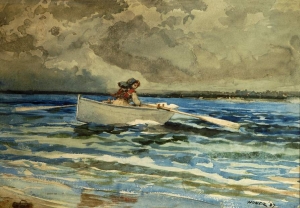
On March 1, 2014, “An American Odyssey: The Warner Collection of American Painting” will open at the Frick Art Museum at the Frick Art & Historical Center in Pittsburgh, Pennsylvania. The exhibition features 50 paintings from the collection of Alabama businessman and philanthropist, Jack Warner. Warner, who is the former CEO of Gulf States Paper Corp., founded Alabama’s Tuscaloosa Museum of Art in 2011.
The exhibition, which spans the entire 19th century, includes works by Gilbert Stuart, Charles Peale Polk, Thomas Cole, Frederic Edwin Church, Severin Roesen, William Merritt Chase, James McNeill Whistler, Winslow Homer, Childe Hassam, Maurice Prendergast, John Henry Twachtman, and Mary Cassatt. The comprehensive show tracks the evolution of painting in the United States from early American portraiture to the romantic paintings of the Hudson River School and the rise of American Impressionism during the tail-end of the century.
“An American Odyssey: The Warner Collection of American Painting,” which was organized by the Warner Foundation, will remain on view at the Frick Art Museum through May 25, 2014.
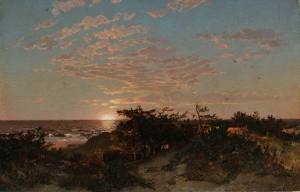
The National Academy Museum in New York presents William Trost Richards: Visions of Land and Sea. The exhibition features approximately 60 works by the 19th century painter from the museum’s permanent collection. The National Academy houses a significant collection of Richards’ works thanks to the estate of the artist’s daughter, Anna Richards Brewster, which bequeathed over 100 works spanning Richards’ career to the museum in 1954.
William Trost Richards, a native of Philadelphia, was an American landscape painter associated with the Hudson River School as well as the American Pre-Raphaelite movement. Richards studied intermittently with the German-born landscape painter Paul Weber in the 1850s and greatly admired the works of Thomas Cole, Frederic Edwin Church and the English Pre-Raphaelites. Richards is best known for his landscapes and marine paintings of Rhode Island, the White Mountains and the shorelines of Great Britain, France and Norway.
William Trost Richards: Visions of Land and Sea will be on view at the National Academy Museum through September 8, 2013.
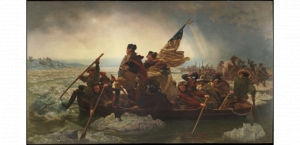
Thomas P. Campbell, Director and CEO of The Metropolitan Museum of Art In New York City announced that one million people have visited the institution’s New Galleries for American Paintings, Sculpture, and Decorative Arts since opening to the public on January 6, 2012. The galleries, which were expanded, reconceived, and reinstalled, average 2,000 visitors per day -- about 11% of the Met’s overall attendance.
The New Galleries present works ranging from the 18th century through the early 20th century arranged in chronological order. Highlights from the New Galleries include Emanuel Gottlieb Leutze’s Washington Crossing the Delaware and works by American masters such as John Singleton Copley, Thomas Cole, Frederic Edwin Church, Winslow Homer, Thomas Eakins, John Singer Sargent, and Frederic Remington.
The renovation of the Met’s New Galleries was part of a comprehensive, decade-long project to redesign the museum’s entire American Wing. The overhaul added 3,300 square feet of gallery space to the American Wing and allowed for a more in-depth presentation of the Met’s remarkable American art collection. Nearly all of the American Wing’s 17,000 holdings are now on view.
We now recognize Frederic Edwin Church (1826–1900) as one of America’s great artists of the nineteenth century. Further, many believe his work done in Maine includes some of his most important images, with Twilight in the Wilderness (Fig. 1), based on a sunset he had sketched at Bar Harbor, Maine, a few years earlier, ranking among the dozen greatest paintings in the history of American art.
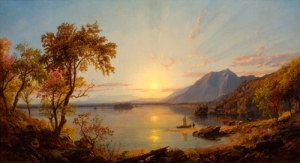
The Fenimore Museum of Art in Cooperstown, NY is currently hosting the exhibition Hudson River School: Nature and the American Vision. The show presents a number of important works by key figures in the movement including Albert Bierstadt (1830-1902), Thomas Cole (1801-1848), Frederic Edwin Church (1826-1900), Jasper F. Cropsey (1823-1900) and Asher Durand (1796-1886). Nature and the American Vision was organized by the New-York Historical Society and made possible by the New York State Council on the Arts.
The exhibition aims to communicate the Hudson River School artists’ fascination with the American landscape. The mid-19th century movement was influenced by romanticism and is defined by its paintings that celebrate nature’s sublimity and exude an almost ethereal quality. Many Hudson River School painters regarded nature as an indefinable manifestation of God, which strongly influenced the movement’s aesthetic qualities.
Hudson River School: Nature and the American Vision will be on view at the Fenimore Museum of Art through September 29, 2013. The Fenimore, which is operated by the New York State Historical Association, specializes in American Folk Art, Indian art and artifacts, 19th century genre painting and American photography.
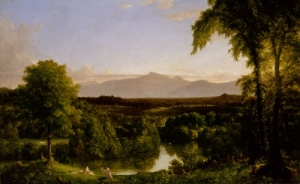
The Hudson River School Art Trail will open for the season on June 22, 2013.The trail boasts guided hikes, which are organized by the Thomas Cole National Historic Site in Catskill, New York and take visitors on a tour of the vistas, mountains and valleys that influenced the Hudson River School painters including Thomas Cole (1801-1848), Frederic Edwin Church (1826-1900), Asher B. Durand (1796-1886), Jasper Francis Cropsey (1823-1900), and Sanford Gifford (1823-1880).
The Hudson River School Art Trail is divided into a number of large geographic areas and allows visitors to walk in the footsteps of some of the most significant artists of the 19th century. The Hudson River School was the first major art movement to sweep America and it dominated the visual arts for over 50 years. The trail includes the home of Thomas Cole who is credited with founding the Hudson River School; Olana, the home of Frederic Edwin Church, an important figure in the movement; and views of the landscapes that are featured in the artists’ paintings.
The Hudson River School Art Trail was expanded last year, more than doubling its size from its original 8 sites in New York to 20 sites in New York, New Hampshire and Massachusetts.
|
|
|
|
|